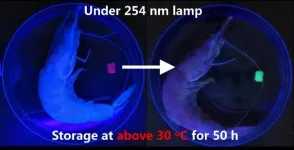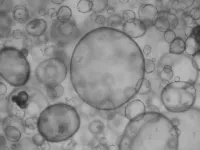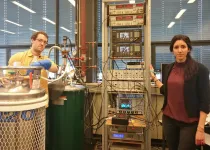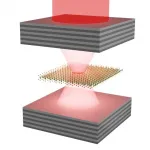Sharks use Earth's magnetic fields to guide them like a map
2021-05-06
(Press-News.org) Sea turtles are known for relying on magnetic signatures to find their way across thousands of miles to the very beaches where they hatched. Now, researchers reporting in the journal Current Biology on May 6 have some of the first solid evidence that sharks also rely on magnetic fields for their long-distance forays across the sea.
"It had been unresolved how sharks managed to successfully navigate during migration to targeted locations," said Save Our Seas Foundation project leader Bryan Keller, also of Florida State University Coastal and Marine Laboratory. "This research supports the theory that they use the earth's magnetic field to help them find their way; it's nature's GPS."
Researchers had known that some species of sharks travel over long distances to reach very specific locations year after year. They also knew that sharks are sensitive to electromagnetic fields. As a result, scientists had long speculated that sharks were using magnetic fields to navigate. But the challenge was finding a way to test this in sharks.
"To be honest, I am surprised it worked," Keller said. "The reason this question has been withstanding for 50 years is because sharks are difficult to study."
Keller realized the needed studies would be easier to do in smaller sharks. They also needed a species known for returning each year to specific locations. He and his colleagues settled on bonnetheads (Sphyrna tiburo).
"The bonnethead returns to the same estuaries each year," Keller said. "This demonstrates that the sharks knows where 'home' is and can navigate back to it from a distant location."
The question then was whether bonnetheads managed those return trips by relying on a magnetic map. To find out, the researchers used magnetic displacement experiments to test 20 juvenile, wild-caught bonnetheads. In their studies, they exposed sharks to magnetic conditions representing locations hundreds of kilometers away from where the sharks were actually caught. Such studies allow for straightforward predictions about how the sharks should subsequently orient themselves if they were indeed relying on magnetic cues.
If sharks derive positional information from the geomagnetic field, the researchers predicted northward orientation in the southern magnetic field and southward orientation in the northern magnetic field, as the sharks attempted to compensate for their perceived displacement. They predicted no orientation preference when sharks were exposed to the magnetic field that matched their capture site. And, it turned out, the sharks acted as they'd predicted when exposed to fields within their natural range.
The researchers suggest that this ability to navigate based on magnetic fields may also contribute to the population structure of sharks. The findings in bonnetheads also likely help to explain impressive feats by other shark species. For instance, one great white shark was documented to migrate between South Africa and Australia, returning to the same exact location the following year.
"How cool is it that a shark can swim 20,000 kilometers round trip in a three-dimensional ocean and get back to the same site?" Keller asked. "It really is mind blowing. In a world where people use GPS to navigate almost everywhere, this ability is truly remarkable."
In future studies, Keller says he'd like to explore the effects of magnetic fields from anthropogenic sources such as submarine cables on sharks. They'd also like to study whether and how sharks rely of magnetic cues not just during long-distance migration but also during their everyday behavior.
INFORMATION:
This work was supported by the Save Our Seas Foundation and the Florida State University Coastal and Marine Laboratory.
Current Biology, Keller et al.: "Map-like use of earth's magnetic field in sharks" https://www.cell.com/current-biology/fulltext/S0960-9822(21)00476-0
Current Biology (@CurrentBiology), published by Cell Press, is a bimonthly journal that features papers across all areas of biology. Current Biology strives to foster communication across fields of biology, both by publishing important findings of general interest and through highly accessible front matter for non-specialists. Visit http://www.cell.com/current-biology. To receive Cell Press media alerts, contact press@cell.com.
ELSE PRESS RELEASES FROM THIS DATE:
2021-05-06
Scientists in China and Germany have designed an artificial color-changing material that mimics chameleon skin, with luminogens (molecules that make crystals glow) organized into different core and shell hydrogel layers instead of one uniform matrix. The findings, published May 6 in the journal Cell Reports Physical Science, demonstrate that a two-luminogen hydrogel chemosensor developed with this design can detect seafood freshness by changing color in response to amine vapors released by microbes as fish spoils. The material may also be used to advance the development of stretchable electronics, dynamic camouflaging robots, and anticounterfeiting technologies.
"This novel core-shell layout does not require a careful choice of luminogen pairs, nor does it require an ...
2021-05-06
Mini-organs or organoids play a big role in the future of medicine. Their countless applications can help develop and implement tailored therapies for each patient. The revolutionary development of organoids started in Utrecht with a group of curious scientists. But when organoid research starting booming, confusion arose. What exactly is an organoid? Are there different types, and if so, what should they be called? A group of experts from around the world now publishes the first consensus on what is - and what is not - an organoid.
Bart Spee, Associate Professor at Utrecht University's faculty of Veterinary Medicine, is ...
2021-05-06
The "Third Pole" of the Earth, the high mountain ranges of Asia, bears the largest number of glaciers outside the polar regions. A Sino-Swiss research team has revealed the dramatic increase in flood risk that could occur across Earth's icy Third Pole in response to ongoing climate change. Focusing on the threat from new lakes forming in front of rapidly retreating glaciers, a team, led by researchers from the University of Geneva (UNIGE), Switzerland, demonstrated that the related flood risk to communities and their infrastructure could almost triple. ...
2021-05-06
New research by Joseph Wu, Edgar Engelman, and colleagues at Stanford University, US has advanced an old concept to develop a new strategy to train the immune system of mice to recognize cancer cells. This work is based on the recent understanding that induced pluripotent stem cells (iPSCs), which are stem cells generated from skin or blood cells through a method called reprogramming, produce a large set of antigens that have overlap to a specific type of pancreatic cancer and that these similarities can be used for potential clinical benefit.
It is well known that vaccines can be highly effective ...
2021-05-06
In spintronics, the magnetic moment of electrons (spin) is used to transfer and manipulate information. An ultra-compact 2D spin-logic circuitry could be built from 2D materials that can transport the spin information over long distances and also provide strong spin-polarization of charge current. Experiments by physicists at the University of Groningen (The Netherlands) and Colombia University (USA) suggest that magnetic graphene can be the ultimate choice for these 2D spin-logic devices as it efficiently converts charge to spin current and can transfer this strong spin-polarization ...
2021-05-06
At extremely low temperatures, matter often behaves differently than in normal conditions. At temperatures only a few degrees above absolute zero (-273 degrees Celsius), physical particles may give up their independence and merge for a short time into a single object in which all the particles share the same properties. Such structures are known as Bose-Einstein Condensates, and they represent a special aggregate state of matter.
An international team of researchers led by physicists Dr Carlos Anton-Solanas and Professor Christian Schneider from the UNiversity of Oldenburg has now succeeded for the first time in generating this unusual quantum state in charge carrier complexes that are closely linked ...
2021-05-06
Hydrogen-based fuels should primarily be used in sectors such as aviation or industrial processes that cannot be electrified, finds a team of researchers. Producing these fuels is too inefficient, costly and their availability too uncertain, to broadly replace fossil fuels for instance in cars or heating houses. For most sectors, directly using electricity for instance in battery electric cars or heat pumps makes more economic sense. Universally relying on hydrogen-based fuels instead and keeping combustion technologies threatens to lock in a further fossil fuel dependency ...
2021-05-06
ROCHESTER, Minn. ? Heart disease can take a number of forms, but some types of heart disease, such as asymptomatic low ejection fraction, can be hard to recognize, especially in the early stages when treatment would be most effective. The ECG AI-Guided Screening for Low Ejection Fraction, or EAGLE, trial set out to determine whether an artificial intelligence (AI) screening tool developed to detect low ejection fraction using data from an EKG could improve the diagnosis of this condition in routine practice. Study findings are published in Nature Medicine.
Systolic low ejection fraction is defined as the heart's inability to contract strongly enough with each beat to pump at least 50% of the blood from ...
2021-05-06
What The Editorial Says: JAMA Health Forum debuts this week as a peer-reviewed, open-access, online journal focused on health policy, health care systems, and global and public health. The journal has transitioned from an online health policy channel and is the newest member of the family of JAMA Network specialty journals. The editor of JAMA Health Forum is John Z. Ayanian, M.D., M.P.P., of the University of Michigan in Ann Arbor, and the deputy editor is Melinda B. Buntin, Ph.D., of the Vanderbilt University School of Medicine in Nashville, Tennessee.
Authors: John Z. Ayanian, M.D., M.P.P., of the University of Michigan in Ann Arbor, is the corresponding author.
To access the embargoed study: Visit our For The Media website at ...
2021-05-06
What The Study Did: Researchers compared health care use among patients with COVID-19 who were enrolled in a home monitoring program with similar patients who were not enrolled.
Authors: Anita D. Misra-Hebert, M.D., M.P.H., of the Cleveland Clinic, is the corresponding author.
To access the embargoed study: Visit our For The Media website at this link https://media.jamanetwork.com/
(doi:10.1001/jamahealthforum.2021.0333)
Editor's Note: The article includes conflict of interest and funding/support disclosures. Please see the article for additional information, including other authors, author contributions and affiliations, conflict of interest and financial disclosures, and funding and support.
INFORMATION:
Media advisory: The full study and editor's ...
LAST 30 PRESS RELEASES:
[Press-News.org] Sharks use Earth's magnetic fields to guide them like a map




